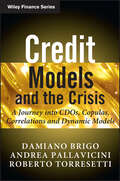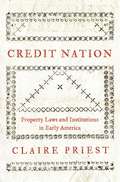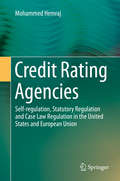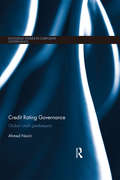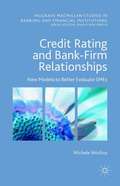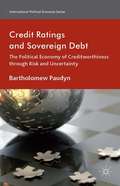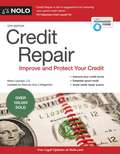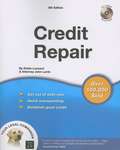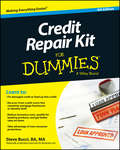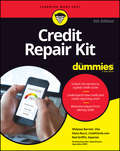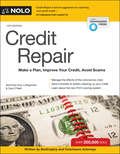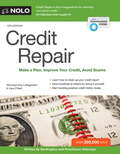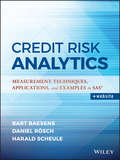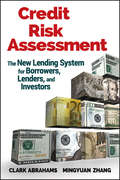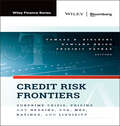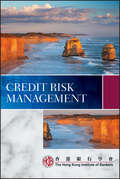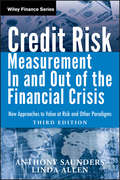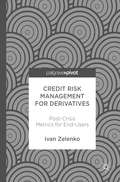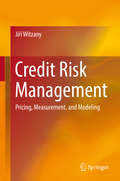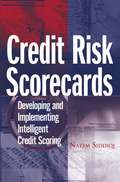- Table View
- List View
Credit Models and the Crisis
by Andrea Pallavicini Damiano Brigo Roberto TorresettiThe recent financial crisis has highlighted the need for better valuation models and risk management procedures, better understanding of structured products, and has called into question the actions of many financial institutions. It has become commonplace to blame the inadequacy of credit risk models, claiming that the crisis was due to sophisticated and obscure products being traded, but practitioners have for a long time been aware of the dangers and limitations of credit models. It would seem that a lack of understanding of these models is the root cause of their failures but until now little analysis had been published on the subject and, when published, it had gained very limited attention.Credit Models and the Crisis is a succinct but technical analysis of the key aspects of the credit derivatives modeling problems, tracing the development (and flaws) of new quantitative methods for credit derivatives and CDOs up to and through the credit crisis. Responding to the immediate need for clarity in the market and academic research environments, this book follows the development of credit derivatives and CDOs at a technical level, analyzing the impact, strengths and weaknesses of methods ranging from the introduction of the Gaussian Copula model and the related implied correlations to the introduction of arbitrage-free dynamic loss models capable of calibrating all the tranches for all the maturities at the same time. It also illustrates the implied copula, a method that can consistently account for CDOs with different attachment and detachment points but not for different maturities, and explains why the Gaussian Copula model is still used in its base correlation formulation.The book reports both alarming pre-crisis research and market examples, as well as commentary through history, using data up to the end of 2009, making it an important addition to modern derivatives literature. With banks and regulators struggling to fully analyze at a technical level, many of the flaws in modern financial models, it will be indispensable for quantitative practitioners and academics who want to develop stable and functional models in the future.
Credit Nation: Property Laws and Institutions in Early America (The Princeton Economic History of the Western World #104)
by Claire PriestHow American colonists laid the foundations of American capitalism with an economy built on creditEven before the United States became a country, laws prioritizing access to credit set colonial America apart from the rest of the world. Credit Nation examines how the drive to expand credit shaped property laws and legal institutions in the colonial and founding eras of the republic.In this major new history of early America, Claire Priest describes how the British Parliament departed from the customary ways that English law protected land and inheritance, enacting laws for the colonies that privileged creditors by defining land and slaves as commodities available to satisfy debts. Colonial governments, in turn, created local legal institutions that enabled people to further leverage their assets to obtain credit. Priest shows how loans backed with slaves as property fueled slavery from the colonial era through the Civil War, and that increased access to credit was key to the explosive growth of capitalism in nineteenth-century America.Credit Nation presents a new vision of American economic history, one where credit markets and liquidity were prioritized from the outset, where property rights and slaves became commodities for creditors' claims, and where legal institutions played a critical role in the Stamp Act crisis and other political episodes of the founding period.
Credit Networks in The Preindustrial World: A Social Network Analysis Approach (Palgrave Studies in the History of Finance)
by Elise M. Dermineur Matteo PompermaierThis open access book examines the formation and sustainability of private credit networks in past societies, gathering a global range of case studies from Europe and the Americas. The book represents a fi rst attempt to coordinate the work of different scholars working on credit networks and aims to explore the possibilities offered by social network analysis for the study of past fi nancial markets and networks. Each contribution offers new perspectives for the comprehension of past fi nancial networks, with a broad chronological and geographical scope. The chapters are arranged thematically and study both rural and urban networks, each employing a network perspective to facilitate an increased understanding of the relational dynamics of preindustrial credit transactions. This book models the various ways that SNA can be utilized by economic and fi nancial historians, as well as discusses its limitations and ways in which it can be combined with qualitative archival research. The book is of interest to a broad audience of scholars in the fi elds of economic, fi nancial and social history.
Credit Portfolio Management: A Practitioner’s Guide to the Active Management of Credit Risks
by Michael HünselerCredit Portfolio Management is a topical text on approaches to the active management of credit risks. The book is a valuable, up to date guide for portfolio management practitioners. Its content comprises of three main parts: The framework for managing credit risks, Active Credit Portfolio Management in practice and Hedging techniques and toolkits.
Credit Rating Agencies: Self-regulation, Statutory Regulation and Case Law Regulation in the United States and European Union
by Mohammed HemrajThe book examines the role of credit rating agencies (CRAs) in the subprime mortgage crisis. The CRAs are blamed for awarding risky securities '3-A' investment grade status and then failing to downgrade them quickly enough when circumstances changed, which led to investors suffering substantial losses. The causes identified by the regulators for the gatekeeper failure were conflicts of interest (as the issuers of these securities pay for the ratings); lack of competition (as the Big Three CRAs have dominated the market share); and lack of regulation for CRAs. The book examines how the regulators, both in the US and EU, have sought to address these problems by introducing soft law self-regulation in accordance with the International Organisation of Securities Commissions Code and hard law statutory regulation, such as that found in the "Reform Act" and "Dodd-Frank Act" in the US and similar provisions in the EU. The highly topical book examines these provisions in detail by using a doctrinal black-letter law method to assess the success of the regulators in redressing the problems identified. It also examines the US case law regulation relating to the legal liability of CRAs. The book examines whether the regulations introduced have had a deterrent effect on the actions of CRAs, whether investors are compensated for their losses, and how the regulators have dealt with the issues of conflicts of interest and an anti-competitive environment. Should liability be introduced for CRAs through changes in the law so as to compel them to issue reliable ratings and solve the current problems? The book seeks to simplify the complex issues involved and is backed by concrete evidence; as such, it will appeal to both the well-informed and the lay general public who are interested in learning more about the role of CRAs in the sub-prime mortgage crisis and regulators' attempts to remedy the situation. Novice readers can familiarise themselves with the legal and financial terminology used by referring to the glossary at the end of the book.
Credit Rating Governance: Global Credit Gatekeepers (Routledge Studies in Corporate Governance)
by Ahmed NaciriCredit rating agencies play an essential role in the modern financial system and are relied on by creditors and investors on the market. In the recent financial crisis, their power and reliability were often questioned, yet a simple rating downgrade could threaten to bankrupt a whole country. This book examines the governance of credit rating agencies, as expressed by their ability to fairly, ethically and consistently assign higher rates to issuers having lesser default risks. However, factors such as the drive for increased revenue and market share, the inadequate business model, the inadequate methodology of assessing risk, opacity and inadequate internal monitoring have all been identified as critical governance failures for credit agencies. This book explores these issues, and proposes some potential solutions and improvements. This will be of interest to researchers and advanced students of corporate finance, finance, financial economics, risk management, investment management, and banking.
Credit Rating and Bank-Firm Relationships: New Models to Better Evaluate SMEs (Palgrave Macmillan Studies in Banking and Financial Institutions)
by Michele ModinaThis book explores the role of the rating system in creditworthiness assessment, looking into its current status, strengths and weaknesses and possible evolution in the light of Basel 3 and the Global Economic Crisis.
Credit Ratings and Sovereign Debt: The Political Economy Of Creditworthiness Through Risk And Uncertainty (International Political Economy Ser)
by B. PaudynBartholomew Paudyn investigates how governments across the globe struggle to constitute the authoritative knowledge underpinning the political economy of creditworthiness and what the (neoliberal) 'fiscal normality' means for democratic governance.
Credit Repair
by Robin Leonard Margaret ReiterClean up your credit with the acclaimed plain English guide to fixing your credit troubles Nearly 80 percent of credit reports contain errors. In a tough economy when credit is tight, you need to be certain that your financial records are correct and up to date. A less than flattering report can hurt your chances of qualifying for credit card, loans, renting an apartment even finding a job. But a bad credit report can almost always be improved or corrected. Credit Repair shows you how to fix your credit situation, explaining the necessary steps in plain English. Learn how to: . decipher your credit report . get mistakes on your credit report fixed . avoid credit discrimination . get positive information added to your credit report . plan a realistic credit repair strategy . negotiate with creditors . avoid future problems by establishing a realistic budget and getting out of debt now Credit Repair includes dozens of forms and letters that will help you spruce up your credit report as easily as possible!
Credit Repair (12th Edition)
by Robin Leonard Amy LoftsgordonWhen debts pile up, it can be impossible to see a way out. And in the meantime, the consequences pile up. Let the sensible strategies in Credit Repair help you take control, clean up your credit report, and live debt-free. assess your debt situation correct errors and improve your credit report and score choose the best repair strategy for your situation prioritize your debts negotiate with creditors to reduce debts add positive information to your credit report avoid identity theft and credit scams build a solid credit history This edition of Credit Repair is completely updated with the latest legal developments, and includes dozens of forms and letters that will help you spruce up your credit report as easily as possible!
Credit Repair (8th edition)
by Robin Leonard John LambLeonard is an attorney and the author or co-author of many of Nolo's personal finance books. Written in plain English, his text explains how to get out of debt, set up a realistic budget, and rebuild "bad" credit. This edition has been completely updated and revised to incorporate the latest information and laws, including new information on identity theft and what to do if you are a victim of it. The text includes 30 forms and letters, both as tear-outs and on the accompanying CD-ROM. Annotation ©2006 Book News, Inc., Portland, OR (booknews.com)
Credit Repair Kit For Dummies
by Steve Bucci<p>Credit card debt is the third largest source of household indebtedness. <li>Credit Repair Kit For Dummies</li> gives you the tools you need to repair your credit. <p>This new edition covers: major changes with the Consumer Financial Protection Bureau's (CFPB) inquiry into overdraft practices and their effect on consumers; dealing with the effect of tightened credit markets on those with good, marginal, or bad credit; best ways to recover from mortgage related score hits or minimize damage after walking away from a home; updated Vantage Score information; updated coverage on reporting programs like FICO Score watch, etc.; what makes a good FICO score today; a new section on significant others (boyfriend/girlfriend/spouse) and credit/debt sharing; Debt Relief Act in a mortgage meltdown situation; the latest tips and advice on dealing with identity theft and annoying collection calls; and more. Online you'll find sample credit reports, forms, templates, and other helpful tools to help whip your credit into shape. <p> <li>Updated credit score examples with new ranges <li>New information about IRS exceptions to the Mortgage Forgiveness <li>Advice and tips about adding information to a credit report, and beefing-up thin credit <li>Useful, downloadable, forms and tools on Dummies.com</li> <p> <p>If you have mediocre credit and want or need to better manage it in order to get a job, reduce insurance costs, qualify for banking products, and more, <li>Credit Repair Kit For Dummies has it covered</li>.</p>
Credit Repair Kit For Dummies (Playaway Adult Nonfiction Ser.)
by Melyssa Barrett Stephen R. Bucci Rod GriffinUnlock the secrets to a great credit score Understand how credit and credit reporting work Minimize impact from identity theft Get on the road to credit recovery today! Need a credit makeover? You're definitely not alone: Millions of Americans are struggling with one or more credit-related issues. But don't despair! Credit Repair Kit For Dummies is packed full of simple, proven methods for escaping the quicksand and taking the concrete steps needed to build up a solid score. Whether you just want to improve your score or make your debt a thing of the past, this book shows you how to put even the worst credit situations behind you and make a poor score a bad—and distant—memory. Inside... Clean up your report Reset your goals Weather a mortgage crisis Settle debt Maintain a good score Evaluate bankruptcy options Plan ahead for the rest of your life Know your rights
Credit Repair: Make a Plan, Improve Your Credit, Avoid Scams
by Amy Loftsgordon Cara O'NeillBad credit can get better A bad credit report can prevent you from getting a mortgage, car loan, credit card, apartment, or even a job. The sensible strategies in Credit Repair help you take control of your finances, clean up your credit report and rebuild your credit. Learn how to: prioritize debts and create a budget reduce debts and cut expenses negotiate with creditors correct credit report errors and remove old information add positive information to your credit report adopt strategies to rebuild your credit, and avoid identity theft and credit repair scams. Updates to the 14th edition of Credit Repair include the new FICO scoring system and federal CARES Act credit reporting guidelines, changes to credit freeze and fraud alert laws, the availability of additional free credit reports during the pandemic, and more. With downloadable forms: Get forms, worksheets, and sample letters—to help you handle debts, clean up your credit, and avoid overspending (details inside).
Credit Repair: Make a Plan, Improve Your Credit, Avoid Scams (13th Edition)
by Robin Leonard Amy Loftsgordon<p>Bad credit can prevent you from getting a mortgage, car loan, credit card, apartment, or even a job. It can also mean paying a bundle in rates and fees for any loans or credit you do get. <p>Use this comprehensive how-to manual to rebuild bad credit and protect improved credit. Learn how to: <p> <li>reduce expenses <li>create a workable budget <li>negotiate with creditors <li>improve your credit score, and <li>protect yourself against identity theft</li> </p>
Credit Risk
by Tomasz Zastawniak Marek Capi SkiModelling credit risk accurately is central to the practice of mathematical finance. The majority of available texts are aimed at an advanced level, and are more suitable for PhD students and researchers. This volume of the Mastering Mathematical Finance series addresses the need for a course intended for master's students, final-year undergraduates, and practitioners. The book focuses on the two mainstream modelling approaches to credit risk, namely structural models and reduced-form models, and on pricing selected credit risk derivatives. Balancing rigorous theory with examples, it takes readers through a natural development of mathematical ideas and financial intuition.
Credit Risk Analytics: Measurement Techniques, Applications, and Examples in SAS
by Bart Baesens Daniel Roesch Harald ScheuleThe long-awaited, comprehensive guide to practical credit risk modeling Credit Risk Analytics provides a targeted training guide for risk managers looking to efficiently build or validate in-house models for credit risk management. Combining theory with practice, this book walks you through the fundamentals of credit risk management and shows you how to implement these concepts using the SAS credit risk management program, with helpful code provided. Coverage includes data analysis and preprocessing, credit scoring; PD and LGD estimation and forecasting, low default portfolios, correlation modeling and estimation, validation, implementation of prudential regulation, stress testing of existing modeling concepts, and more, to provide a one-stop tutorial and reference for credit risk analytics. The companion website offers examples of both real and simulated credit portfolio data to help you more easily implement the concepts discussed, and the expert author team provides practical insight on this real-world intersection of finance, statistics, and analytics. SAS is the preferred software for credit risk modeling due to its functionality and ability to process large amounts of data. This book shows you how to exploit the capabilities of this high-powered package to create clean, accurate credit risk management models. Understand the general concepts of credit risk management Validate and stress-test existing models Access working examples based on both real and simulated data Learn useful code for implementing and validating models in SAS Despite the high demand for in-house models, there is little comprehensive training available; practitioners are left to comb through piece-meal resources, executive training courses, and consultancies to cobble together the information they need. This book ends the search by providing a comprehensive, focused resource backed by expert guidance. Credit Risk Analytics is the reference every risk manager needs to streamline the modeling process.
Credit Risk Assessment: The New Lending System for Borrowers, Lenders, and Investors
by Mingyuan Zhang Clark R. Abrahamsists through the workings of financial markets, particularly how they value, price, and distribute risk." -Professor William Greene, Stern School of Business, New York University "This book is a well-timed departure from much of what is being written today regarding the current foreclosure and credit crisis. Rather than attempting to blame lenders, borrowers, and/or federal regulators for the mortgage meltdown and the subsequent impacts on the financial markets, Clark and Mingyuan have proposed a groundbreaking new framework to revolutionize our current lending system. The book is built on the authors' deep understanding of risk and the models used for credit analysis, and reflects their commitment to solve the problem. What I find most profound is their passion to develop a system that will facilitate new and better investment, especially in underserved urban markets that have been disproportionately impacted in the current crisis. I applaud the authors for this important work, and urge practitioners and theorists alike to investigate this new approach." -John Talmage, President and CEO, Social Compact "In the wake of the credit crisis, it is clear that transparency is the key to not repeating history. In Credit Risk Assessment: The New Lending System for Borrowers, Lenders and Investors, Clark Abrahams and Mingyuan Zhang describe a new lending framework that seeks to connect all the players in the lending chain and provide a more holistic view of customers' risk potential. As the financial services industry recovers from the mortgage meltdown, the Abrahams/Zhang lending model certainly offers some new food for thought to laymen and professionals alike." -Maria Bruno-Britz, Senior Editor, Bank Systems & Technology magazine
Credit Risk Frontiers
by Damiano Brigo Tomasz Bielecki Frederic PatrasA timely guide to understanding and implementing credit derivativesCredit derivatives are here to stay and will continue to play a role in finance in the future. But what will that role be? What issues and challenges should be addressed? And what lessons can be learned from the credit mess?Credit Risk Frontiers offers answers to these and other questions by presenting the latest research in this field and addressing important issues exposed by the financial crisis. It covers this subject from a real world perspective, tackling issues such as liquidity, poor data, and credit spreads, as well as the latest innovations in portfolio products and hedging and risk management techniques.Provides a coherent presentation of recent advances in the theory and practice of credit derivativesTakes into account the new products and risk requirements of a post financial crisis worldContains information regarding various aspects of the credit derivative market as well as cutting edge research regarding those aspectsIf you want to gain a better understanding of how credit derivatives can help your trading or investing endeavors, then Credit Risk Frontiers is a book you need to read.
Credit Risk Management
by The Hong Kong Institute of BankersThe importance of managing credit and credit risks carefully and appropriately cannot be overestimated. The very success or failure of a bank and the banking industry in general may well depend on how credit risk is handled. Banking professionals must be fully versed in the risks associated with credit operations and how to manage those risks. This up-to-date volume is an invaluable reference and study tool that delves deep into issues associated with credit risk management. Credit Risk Management from the Hong Kong Institute of Bankers (HKIB)discusses the various ways through which banks manage risks. Essential for candidates studying for the HKIB Associateship Examination, it can also help those who want to acquire a deeper understanding of how and why banks make decisions and set up processes that lower their risk. Topics covered in this book include: Active credit portfolio management Risk management, pricing, and capital adequacy Capital requirements for banks Approaches to credit risk management Structural models and probability of default Techniques to determine loss given default Derivatives and structured products
Credit Risk Management In and Out of the Financial Crisis
by Allen Linda Anthony SaundersA classic book on credit risk management is updated to reflect the current economic crisis Credit Risk Management In and Out of the Financial Crisis dissects the 2007-2008 credit crisis and provides solutions for professionals looking to better manage risk through modeling and new technology. This book is a complete update to Credit Risk Measurement: New Approaches to Value at Risk and Other Paradigms, reflecting events stemming from the recent credit crisis. Authors Anthony Saunders and Linda Allen address everything from the implications of new regulations to how the new rules will change everyday activity in the finance industry. They also provide techniques for modeling-credit scoring, structural, and reduced form models-while offering sound advice for stress testing credit risk models and when to accept or reject loans. Breaks down the latest credit risk measurement and modeling techniques and simplifies many of the technical and analytical details surrounding them Concentrates on the underlying economics to objectively evaluate new models Includes new chapters on how to prevent another crisis from occurring Understanding credit risk measurement is now more important than ever. Credit Risk Management In and Out of the Financial Crisis will solidify your knowledge of this dynamic discipline.
Credit Risk Management for Derivatives: Post-Crisis Metrics for End-Users
by Ivan ZelenkoThis Palgrave Pivot assesses the impact of the regulatory framework for derivatives built post-crisis and examines its ambition to centralize and minimize credit risk, enhance transparency, and regain control. Zelenko delves into the powerful destabilizing forces exerted by derivatives markets in the global financial meltdown of 2008. Recapping the evolution in markets and counterparty risk management, as well as key aspects of regulation and their impact, this book aims to give readers the big picture and foster a deep understanding of the role of derivatives markets in the financial crisis. This practical angle will give useful keys to end-users and their risk managers, as they are faced with a new, complex, and changing environment. Additionally, this book conducts a comprehensive analysis of the new metrics the market has created to model, price, and manage credit risk, such as the Credit Value Adjustment (CVA), the Debt Value Adjustment (DVA), or the Funding Value Adjustment (FVA), and takes full stock of a domain that is still in rapid evolution. This volume covers the concepts, methods, and approaches taken by banks to manage counterparty credit risk in their derivatives activities in the new post-crisis market and regulatory environment, and it aims to highlight what is practical and effective today.
Credit Risk Management for Indian Banks
by K VaidyanathanCredit Risk Management for Indian Banks is a one-stop reference book for practising credit risk professionals in the Indian banking sector. This is the first book of its kind, which is exclusively targets the practical needs of Indian bankers. It lays more emphasis on the ground realities of Indian banking and enunciates principles and guidelines of credit risk management based on real-life situations.
Credit Risk Management: Pricing, Measurement, and Modeling
by Jiří WitzanyThis book introduces to basic and advanced methods for credit risk management. It covers classical debt instruments and modern financial markets products. The author describes not only standard rating and scoring methods like Classification Trees or Logistic Regression, but also less known models that are subject of ongoing research, like e. g. Support Vector Machines, Neural Networks, or Fuzzy Inference Systems. The book also illustrates financial and commodity markets and analyzes the principles of advanced credit risk modeling techniques and credit derivatives pricing methods. Particular attention is given to the challenges of counterparty risk management, Credit Valuation Adjustment (CVA) and the related regulatory Basel III requirements. As a conclusion, the book provides the reader with all the essential aspects of classical and modern credit risk management and modeling.
Credit Risk Scorecards
by Naeem SiddiqiPraise for Credit Risk Scorecards"Scorecard development is important to retail financial services in terms of credit risk management, Basel II compliance, and marketing of credit products. Credit Risk Scorecards provides insight into professional practices in different stages of credit scorecard development, such as model building, validation, and implementation. The book should be compulsory reading for modern credit risk managers."--Michael C. S. Wong Associate Professor of Finance, City University of Hong Kong Hong Kong Regional Director, Global Association of Risk Professionals"Siddiqi offers a practical, step-by-step guide for developing and implementing successful credit scorecards. He relays the key steps in an ordered and simple-to-follow fashion. A 'must read' for anyone managing the development of a scorecard."--Jonathan G. Baum Chief Risk Officer, GE Consumer Finance, Europe"A comprehensive guide, not only for scorecard specialists but for all consumer credit professionals. The book provides the A-to-Z of scorecard development, implementation, and monitoring processes. This is an important read for all consumer-lending practitioners."--Satinder Ahluwalia Vice President and Head-Retail Credit, Mashreqbank, UAE"This practical text provides a strong foundation in the technical issues involved in building credit scoring models. This book will become required reading for all those working in this area."--J. Michael Hardin, PhD Professor of StatisticsDepartment of Information Systems, Statistics, and Management ScienceDirector, Institute of Business Intelligence"Mr. Siddiqi has captured the true essence of the credit risk practitioner's primary tool, the predictive scorecard. He has combined both art and science in demonstrating the critical advantages that scorecards achieve when employed in marketing, acquisition, account management, and recoveries. This text should be part of every risk manager's library."--Stephen D. Morris Director, Credit Risk, ING Bank of Canada
